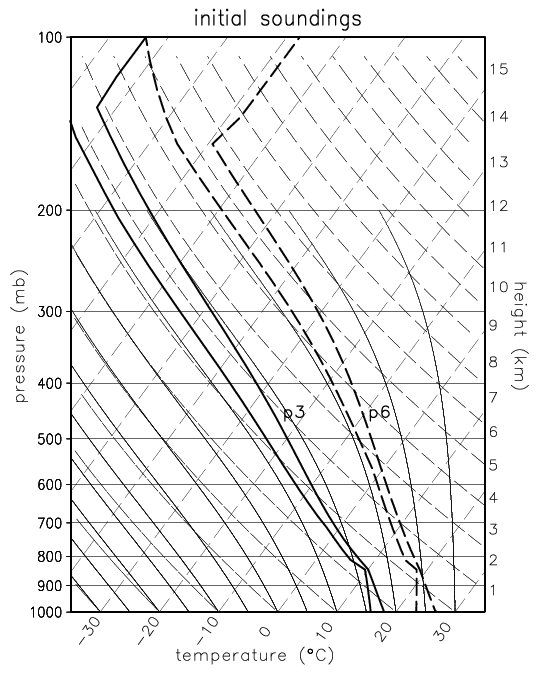

Poster presentation at the 2007 AGU Fall Meeting, abstract H31B-0355.
Recipient of an AGU Outstanding Student Paper Award in Hydrology |
We identify the background environmental conditions that harbor convective storms with the most precipitation, considering both rain and hail.
Relationships between environmental conditions and the precipitation characteristics of simulated storms in a large eight-dimensional parameter space study are investigated. Specifically, we explore which environmental parameters are associated with the greatest production of rain and hail, both aloft and near the surface. The rainwater and hail mixing ratios for each experiment are averaged during the second hour of 2 h simulations to assess the precipitation production of each storm. Multiple linear regressions of the mixing ratios to the environmental parameters are then performed, to identify the parameters most correlated to the production of rain and hail. Although our results do not characterize the amount of point rainfall that would be observed from a particular storm, relationships between mature storm mean rainfall and properties of the environmental profile are found.
The environmental temperature, related to atmospheric precipitable water (PW), exerts considerable influence over the precipitation characteristics of the simulated storms. When atmospheric PW increases, storms generally produce more rain and hail aloft, although less hail is observed near the surface owing to the increased depth of the melting layer. The ambient shear profile also affects the amount of rainfall, since general storm morphology and evolution are affected by the environ-mental wind shear. The level of free convection (LFC) and vertical distribution of buoyancy have some additional influence. Rain and hail production exhibit reduced predictability (in a linear regression sense) compared to other storm properties, such as updraft intensity. These findings demonstrate the degree of influence that environmental conditions can have on convective storm organization and may offer insight into the difficulties associated with forecasting convective rainfall.
 |
 |

Shown below are two example initial soundings. In these profiles, “p3” denotes PW near 30 mm, and “p6” 60mm. PW is implemented as cloud base temperature in our simulations, with approximately 8 °C difference between the two cases. Also in these example profiles, LCL=LFC=1.6 km.

A recently submitted paper (Kirkpatrick et al., to GRL) explores storm updraft intensity and area. Here, we consider precipitation production: namely, five parameters that describe it:
As an example, consider the production aloft of rain (RMAX) and hail (HMAX) as a function of CAPE, shown in the figure below. There is a marked increase in overall precipitation as bulk CAPE increases, and this is not surprising.

The three environmental parameters that explain the greatest amount of variability in surface precipitation are bulk CAPE (discussed above), bulk wind shear (in our case, the hodograph radius), and the height of the LFC. The six panels below depict the increase in surface precipitation as a function of hodograph radius (increasing from left to right) and LFC (increasing from bottom to top). The total mass of precipitation produced is given as Mw.

Using only four of the seven variable COMPASS parameters above, we can explain about 60 percent of the variability in RAREA0, RMAX, RMAX0, and HMAX. Using all seven parameters, we can explain about 70 percent of the variability. Note that in all simulations, FTRH is kept constant and thus is not considered here.
We create this graph by identifying the single parameter with the best linear regression with the storm property, then the group of two parameters with the best regression, etc. As expected, there is "diminishing return" near the final stages, as there are some environmental conditions that apparently are not related to precipitation production.

HMAX0, the surface hail mixing ratio, is the most difficult property to predict. It is highly dependent upon environmental temperature (T-LCL in our simulations), and many of our warm cloud base simulations produce no hail at the surface, likely affecting the results for HMAX0. For the remaining storm properties, the three most important environmental conditions are:

We find unique sensitivity between precipitation production and a storm's ambient environment. The bulk CAPE, bulk shear, and LFC height appear to explain a sizeable (~55%) amount of the variability in surface rainfall.
Overall storm precipitation production of rain and hail (i.e., at upper levels) is driven by the above three parameters as well as the low-level concentration of buoyancy. However, the existence of hail at the surface is modulated strongly by the environmental temperature, which dictates the amount of melting experienced by falling hydrometeors.
Although a representative subset of simulations is presented above, these trends are consistent in most of the COMPASS parameter space. Increasing CAPE, shear, and the LFC height, within reasonable bounds, leads to stronger, more organized storms, and more surface precipitation.
We have also submitted (Dec. 2007) a paper to GRL describing properties of the updrafts of our simulated storms. Future papers will examine other storm properties, such as outflows and cold pools.
This work should be cited as: Kirkpatrick, C., E. W. McCaul, Jr., and C. Cohen (2007), The environmental parameters that influence simulated convective storm precipitation: Results from a large parameter space study, Eos. Trans. AGU, 88(52), Fall Meet. Suppl., Abstract H31B-0355.
For additional information about COMPASS, please visit our website. The information on this page is the same as that found on the actual poster. If desired, I will be happy to provide a PDF reprint. Just email me.